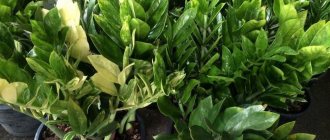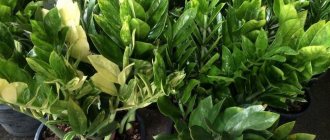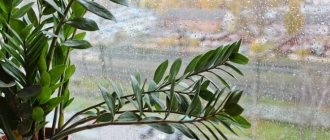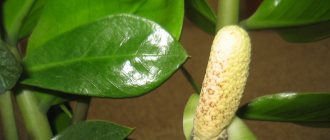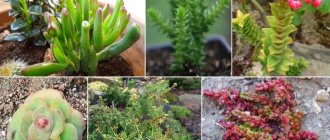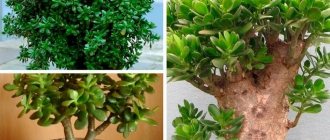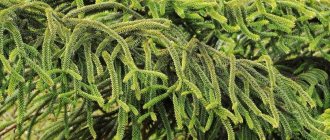Features of Zamioculcas
Zamioculcas is an evergreen perennial and succulent. Found naturally in the tropical forests of the African continent. In Russia, Zamioculcas is known as the dollar tree.
Breeding and growing the plant does not cause much trouble, so it is actively used in landscaping offices, terraces and loggias. The dollar tree does not look quite ordinary: it does not have a trunk or stems, and what grows from the ground is called a compound leaf and is formed from the root system of the plant (see photo).
But the main feature of the indoor Zamioculcas flower is its ability to accumulate moisture reserves, which it uses during unexpected droughts. If there is no water for a long period, then the plant enters the dormant phase, shedding its leaf blades.
Signs associated with the flower
Zamioculcas, along with plants such as Crassula, is considered a money flower. A dollar tree bursting with health brings financial well-being to the home. To do this, according to Feng Shui, it is recommended to place the plant in an apartment where the windows face southeast.
Some signs associated with the dollar tree:
- Suddenly a new segment of rakhis has appeared - expect a small monetary profit.
- The leaves turn yellow and fall off - a warning about a deterioration in your financial situation.
- The plant has bloomed - an unmarried girl will soon meet her betrothed.
Despite the fact that zamioculcas has undeservedly received a reputation as a flower of celibacy, many unmarried people grow it and successfully build their personal lives. There are many signs and superstitions associated with the dollar tree. To believe in them or not is everyone’s business.
Sources
- https://glav-dacha.ru/dollarovoe-derevo/
- https://zen.yandex.ru/media/iogorod/dollarovoe-derevo-cvetenie-zamiokulkasa-uhod-v-domashnih-usloviiah-5e5620de67bb927569fbb851
- https://votinteresno.ru/dollarovoe-derevo-ukhod-v-domashnikh-usloviyakh/
- https://ogorod365.com/zamiokulkas-dollarovoe-derevo-vyrashhivanie-i-uhod-v-domashnih-usloviyah/
- https://hoznauka.ru/rasteniya/dollarovoe-derevo.html
- https://www.botanichka.ru/article/10-pravil-vyirashhivaniya-zamiokulkasa-v-domashnih-usloviyah/
- https://glav-dacha.ru/ukhod-za-zamiokulkasom-v-domashnikh-usloviyakh/
- https://sadovnikam.ru/442329a-dollarovoe-derevo-foto-kak-tsvetet-opisanie-i-uhod-v-domashnih-usloviyah
- https://CvetnikInfo.ru/komnatnye-tsvety/pravila-uhoda-za-zamiokulkas-v-domashnih-usloviyah.html
- https://moyasotka.com/tsvety/komnatnye/zamiokulkas/dollarovoe-derevo-uhod-v-domashnih-usloviyah.html
- https://babushkinadacha.ru/cvety/zamiokulykas.html
- https://pocvetam.ru/komnatnye-rasteniya/dekorativno-listvennye/zamiokulkas-peresadka.html
- https://krrot.net/zamiokylkas-v-domashnix-ysloviyax/
- https://stroy-podskazka.ru/zamiokulkas/opisanie/
- https://RoomFlower.ru/komnatnye-tsvety/sukkulenty/kak-cvetet-zamiokulkas.html
- https://pocvetam.ru/komnatnye-rasteniya/dekorativno-listvennye/dollarovoe-derevo-zamiokulkas.html
- https://vashcvetok.ru/rasteniya/dekorativno-listvennye/zamiokulkas-uhod
[collapse]
Growing Zamioculcas
Zamioculcas is not a demanding plant, so even a beginner can cope with its cultivation and care. Nevertheless, you need to follow some rules, understand the characteristics of the plant, know its needs and how they are satisfied in natural growing conditions. All this is necessary in order to, when growing zamioculcas in the house, recreate conditions for it that are as close as possible to natural ones.
A different approach
There is not the only method to increase the number of handsome men at home, as mentioned earlier. It is also possible to propagate Zamioculcas at home using cuttings.
To do this, you need to complete a number of steps:
- cut the stem slightly higher than the soil level;
- between the leaves in the middle the stem is cut into pieces; for this, a leaf with a bud or a piece of the stem is used;
- within an hour the stems dry out;
- then the stem cutting is squeezed into vermiculite; it is necessary to water it;
- The rooting process can stretch from several weeks to several months; the better you take care of your plant, the faster it will reproduce.
So, if all these subtleties are observed, it will be possible to achieve excellent results in the field of plant propagation.
Reproduction of Zamioculcas by branch:
Caring for a dollar tree at home
Caring for a dollar tree at home involves performing the following procedures:
- maintaining temperature and humidity in the room;
- watering;
- fertilizing;
- garter.
Regular inspection for the presence of pests and diseases and preventive treatment of the plant are also important.
Illumination
One of the important points for caring for zamioculcas is sufficient lighting in the room. Despite the flower's need for sunlight, it should be protected from direct sunlight, especially after watering - the leaves can get burned. In a room where there is not enough light, the leaves become thinner and the flower quickly loses its attractive appearance. The optimal conditions for the plant are light partial shade.
Temperature
Zamioculcas is an unpretentious flower to care for, but it requires compliance with a certain temperature regime, because its appearance and full development depend on this. The optimal temperature in winter is +16...+18 °C, in summer - +22...+28 °C. Temperatures below +12 °C in winter are considered critical, and above +38 °C for the warm season.
Watering
How to water a dollar tree to keep it healthy? The plant does not tolerate excessive moisture and stagnation of water in the pan. Overdrying the soil is unacceptable, since the flower begins to use up internal reserves and will lose its upper leaves. It is necessary to water Zamioculcas as soon as the soil dries out after the last moistening, and the water should be at room temperature.
Air humidity
The flower does not require high humidity, it does not need irrigation, since it is adapted to growing in dry climates. Moreover, dry air is better for this plant than humid air. It is enough to wipe each sheet with a damp cloth as needed to remove accumulated dust.
Bloom
Zamioculcas flowering is a rare phenomenon even in its natural habitat. If the culture develops in comfortable conditions, then sometimes this happens, but only with a plant at least 2–3 years old.
You can make Zamioculcas bloom if you create favorable growing conditions for it.
Fertilizers
The plant must be fed periodically to stimulate the growth and development of the flower. It is important to combine fertilizer application with watering. The procedure must be performed once a week. The exception is the dormant period of the plant. The answer to the question of how to feed zamioculcas is very simple: complex store-bought fertilizers for succulents.
Garter
How to care for a dollar tree throughout the life of the plant? Adult specimens often reach 1 m in height, so there comes a time when they need support. The best solution is to use a wooden or plastic ring. Otherwise, the plant will fall apart and some branches will break off.
Zamioculcas transplant
The first transplant will be required almost immediately after purchasing the plant. As soon as Zamioculcas adapts to new conditions, it should be planted in a new pot, changing the soil. Next, the flower is replanted as the root system grows and develops. On average, this needs to be done once every 2–4 years.
During the procedure, you should try not to injure the roots, as they are very fragile and sensitive. The soil needs to be loose, nutritious, with neutral acidity. You can cook it yourself. The following components will be required in equal parts:
- peat;
- coarse sand;
- leaf and turf soil.
You should choose a strong, stable pot, since the flower grows large. With each transplant, the capacity should be larger than the previous one.
Choosing a pot
When choosing the right pot for growing zamioculcas, you should take into account the characteristics of the plant's root system. Having strong roots, the dollar tree can easily break through a plastic pot as it grows. The advantage of plastic containers is that it is much easier to break it and free the plant without damaging its roots.
Clay and ceramic pots are more suitable for growing large plants due to their greater stability and weight. Natural materials also have good thermoregulation, retaining heat in cold rooms and not warming up in the sun. Therefore, the dollar tree will feel better in a spacious container made of clay or ceramics. Plastic should only be chosen for growing young plants, as a temporary shelter.
Please note that the new pot should be 3-4 cm deeper and wider than its predecessor, and there must be holes at the bottom to drain excess liquid. Before planting the plant, fill it a quarter full with a layer of drainage.
Depending on the age of the flower, drainage materials may vary. For young plants up to 3 years old, polystyrene foam can be used. Older zamioculcas should be planted in pots filled with pebbles or expanded clay. This will make the container more stable. Regardless of the type of drainage, it should be covered with a thick layer of sand.
Rest period
The dollar tree is distinguished by its need for a long period of dormancy. It must be arranged from mid-autumn to early spring. To do this, move the pot to a cool, well-lit room. The recommended temperature is 16-18 degrees. It is required to maintain it at the same level. The plant is watered less frequently, approximately once every 20-30 days. Applying fertilizers during this period is strictly prohibited, since then the dollar tree will not be able to rest and will direct all remaining energy to useless growth.
Looking at a flower from the side
The dollar tree is a neat bush with original leaves, which are covered with a thin layer of waxy coating and consist of 8 or 12 separately growing feathers. Each specimen has a fleshy structure in which moisture accumulates in case of dry periods. The tuberous rhizome also retains water in a similar way. It is often called a natural reservoir of moisture for a rainy day.
The dollar tree can grow up to a meter in height and decorate any home interior. Unlike the money tree (crassula), it periodically blooms with an unusual inflorescence. When you look at the flower from the side, it seems that a yellow or cream-colored corncob has appeared among the fleshy leaves.
In fact, this standing bud consists of many miniature flowers that shine brightly in the afternoon sun. Usually the inflorescence is hidden under a light green blanket, so it is not immediately noticeable. The photo clearly shows the dollar tree during its flowering period.
Since the plant originated from the tropics, it is quite rare to see its buds in Europe. However, the flower is prized for its attractive foliage.
The plant was first described in 1828 by the famous collector of tropical flora K. Loddiges. He named it Caladium zamyefolia. 28 years later, Heinrich Schott, an Austrian biologist, included it in the list of tropical plants as Zamioculcas Loddiges. Only in 1908 did the director of the botanical garden in Berlin immortalize his modern name. Despite this, many indoor plant lovers know the flower under the name dollar tree.
Since the plant blooms very rarely, its leaves are considered its main advantage. It grows up to 100 cm and above, when suitable conditions are created. How to achieve this result when caring for a flower? It turns out it's not difficult. The main thing is to follow simple tips.
Since Zamioculcas is considered a poisonous plant, replanting or pruning is performed with gloves. Otherwise, getting the juice on exposed skin leads to unpleasant burns that take a long time to heal.
Reproduction
You can propagate a dollar tree in several ways:
- dividing the bush;
- cuttings;
- propagation by leaf blade.
When cuttings, the first root will appear after 1–2 months, and a full-fledged plant can be obtained after 7–8 months.
How to plant zamioculcas using the method of dividing a bush? First of all, the roots are carefully separated from each other, and then each part is planted in the ground as an independent plant and watered very sparingly.
Leaf propagation is the simplest and most accessible method, however, a full-fledged plant will form only after 6–7 months. Each of these methods has its own advantages. Let's take a closer look at them.
Cuttings
The most popular way to get a mini dollar tree specimen. To do this, you only need a good cutting from a mature plant and suitable soil: steamed substrate without humus, fine sand, sphagnum or coconut fiber. You also need to prepare small pots for seedlings or ordinary plastic cups. The main thing is that there are holes in the container to drain the liquid.
However, you need to remember that zamioculcas leaves germinate very slowly: the tuber and roots form in 2–3 months, and you will have to wait up to six months for the first leaves.
The procedure is as follows:
- Cut the zamioculcas leaf at the base and use a sharp knife to carefully divide it into cuttings along the internodes. The correct cutting has 1–2 leaves and a whole leaf node.
- Treat the cut parts with a slurry of activated carbon and water and dry.
- After drying, plant the cuttings in the ground with the bottom of the leaf node.
- Watering is not required for the first two days, then moderate soil moisture is recommended. Along with watering, it is necessary to spray the cuttings with water.
Dollar tree cuttings can be rooted not only in soil, but also in water. In this case, it is much easier to control the rooting process.
- A cutting 7–10 cm in length is cut from the top of the leaf and cleared of the lower leaves, leaving 2–3 at the top.
- The future tree is immersed in a transparent container and filled halfway with water. It is necessary to maintain the fluid level and add it from time to time.
- The roots are fully formed in 2–3 months, after which the plant is transplanted into the ground.
How to grow Zamioculcas from a leaf
Only healthy, large and well-developed leaf blades of adult plants are suitable for propagating a dollar tree using leaves: they contain a sufficient amount of nutrients that allow the new plant to take root and take root.
To propagate Zamioculcas with leaves, follow our instructions:
- Cut off the leaf blade with a sharp knife.
- Treat it with Kornevin or any similar substance that stimulates root formation. Dry the sheet for 2-3 hours.
- Bury the plant 1/3 of the way into moist, loose soil.
- Water regularly but sparingly. It is important not to allow the soil to dry out or stagnate water.
The average period for the formation of the root system is 2 months.
By dividing the tuber
This is the fastest way to propagate zamioculcas, but you should carefully select the material for transplantation: only fully formed specimens with several new growth points on the surface of the earth are suitable.
To successfully divide a plant, you need:
- Carefully and carefully remove the plant from the pot and shake off the roots from the ground.
- Identify parts of the plant that can be separated. They must have their own tuber, roots and a rosette with several leaves.
- Using a sharp knife, divide the root system, trying to make as few unnecessary movements as possible.
- Treat the sections with activated carbon and leave to dry.
- Then plant new plants in separate containers and water.
Trimming
Pruning is not a prerequisite for proper plant care. It is carried out only to give it a certain shape or rejuvenation. You can trim any part of the plant: tuber, leaves, cuttings. The main thing is that the pruning tool is very sharp and sterile. A scalpel, garden pruning shears, and a sharp knife will do.
Also read: Kalanchoe: varieties with photos and descriptions
The cut area must be sprinkled with crushed activated carbon. This will quickly stop the leakage and block access to the “wound” for pathogenic microorganisms. Often pruning is used to treat the currency tree.
Diseases and pests
Zamioculcas is susceptible to attacks by the following insects:
- scale insect;
- aphid;
- spider mite;
- mealybugs;
- thrips.
Having discovered parasites, you should review the care: watering regime, adjust the humidity and temperature in the room where the tree is grown. As a preventative measure, it is necessary to frequently inspect the plant, and at the first sign of an insect attack, use specialized preparations.
Zamioculcas is susceptible to some diseases, including root rot, the appearance of dark spots, and yellowing of leaves. The causes of diseases also lie in improper care.
Varieties of Zamioculcas
The most famous varieties of flowers include:
- Zamioculcas zamifolia;
- Zamioculcas lanceolate;
- Zamioculcas variegata;
- Zamioculcas variegated.
They differ from each other in the shape and shade of the leaf plates, as well as in density and size.
Zamioculcas zamifolia
The most common representative of the plant. The bush reaches 70–90 cm in height, has bright green leathery leaves with fleshy petioles.
Popular varieties:
- "Lucky", or round-leaved zamioculcas. Its bright green leaves have a regular circle shape. It grows no more than half a meter in height. This variety develops faster than others.
- "Zamikro". Low-growing hybrid (no more than 60–70 cm in height). The leaves are small, no more than 5 cm.
- "Black Raven" reaches a height of 75 cm. Mature leaves are dark green in color and appear black from a distance. Young leaves stand out against their background with their light green color. Grows well in the shade without changing color.
Zamioculcas lanceolata
This type of dollar tree has an unusual elongated lanceolate leaf shape. Its only representative with the same name is a small bush up to 30 cm high.
Zamioculcas variegata
This species is easily recognized by the specific marbled color of its leaves. Adult specimens grow up to 1.5 in height. It is rarely found on sale. Many plants can only be found through collectors.
Popular varieties:
- 'Long Leave' has long, dark green leaves with lemon-colored stripes of varying widths. Leaf petioles grow up to 80 cm in length.
- "Short Liv" is distinguished by bright white inclusions and stripes on the leaf blades. The petioles are short, green or white-green with a purple tint. The leaves do not exceed 10 cm in length and grow close to each other. This variety grows no more than half a meter in height.
- "Big Leaves" stands out with its rich yellow color, so bright that it seems that the plant is about to shed its leaves. The leaf petioles are pale green in color, with a purple tint.
About the plant
The plant got its name from its glossy leaves. From one large leaf, a dozen more small ones grow. With good care, the tree grows up to 1.2 m. It has a tuberous root that accumulates liquid, which the plant begins to consume during drought.
A tree growing in an apartment blooms very rarely. The buds can be pale pink, white or slightly yellowish, covered with a large leaf, similar to a spathiphyllum flower.
In order for a tree to produce a bud, the following conditions must be created for it:
- watering 1-2 times a week;
- temperature 22-23ºC;
- good lighting (it is recommended to additionally use phytolamps).
If you strictly follow the rules of agricultural technology, you can achieve flowering already in the second year of life.
A tree growing in an apartment blooms very rarely. The illustration for the article is used under the standard license ©dachnyedela.ru

